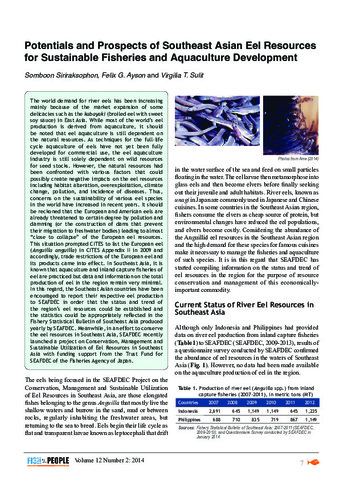Status of resource enhancement and sustainable aquaculture practices in Japan
- Global styles
- MLA
- Vancouver
- Elsevier - Harvard
- APA
- Help
Share
Abstract
Contrary to the rapid increase in the world aquaculture production, fish production in Japan has been decreasing slightly due to the decreasing trend in seafood consumption of Japanese. Aquaculture production is approximately 20% in terms of yield, and 30% in terms of market value, of the country s total fisheries production. In Japan, about 80 species are targeted for release for sea ranching and resource enhancement purposes. The local governments (prefectures) are the main driving force in resource enhancement programs. Chum salmon, Oncorhynchus keta, and scallop Mizuhopecten yessoensisis are examples of successful resource enhancement in Japan. Japanese flounder, Paralichthys olivaceus, and red seabream, Pagrus major, represent intensely released fish species in Japan, and around 10% of the total catch of those species are estimated as released fish. The low price of products and increasing costs of production, such as costs of fuel and fish meal, are the major pressing issues in coastal fisheries and aquaculture in Japan. For aquaculture, the guarantee of food safety, minimization of environmental impact, and management of natural stock populations are highly necessary in order to achieve the sustainability of the industry. For resource enhancement, budget constraint is the major issue, and possible impact on natural stocks caused by released fish should also be considered. The Government of Japan (GOJ) is implementing some measures to rectify unstable business practices of aquaculture and to improve production techniques in aquaculture. For resource enhancement, the GOJ encourages cooperation among local governments (prefectures) for seed production and release of certain targeted species in order to reduce the cost and improve the efficiency of stock enhancement. In Japan, traditionally, the purpose for release was mainly sea ranching, namely harvesting all released animals. Nowadays, actual resource enhancement, i.e. the integrated release program including resource management and development of suitable nursery for released fish, is encouraged by the government. The evaluation and counter measures for the negative impact of stocked fish on genetic diversity of the wild population are also implemented. Recently, marked progress was achieved in seed production technologies of two important tropical fish species, namely coral trout, Plectropomus leopardus, and humphead wrasse, Cheilinus undulatus. These technologies are expected to contribute to the advancement of the aquaculture industry in the South East Asian region.
Suggested Citation
Okuzawa, K., Takebe, T., Hirai, N., & Ikuta, K. (2015). Status of resource enhancement and sustainable aquaculture practices in Japan. In M. R. R. Romana-Eguia, F. D. Parado-Estepa, N. D. Salayo, & M. J. H. Lebata-Ramos (Eds.), Resource Enhancement and Sustainable Aquaculture Practices in Southeast Asia: Challenges in Responsible Production of Aquatic Species: Proceedings of the International Workshop on Resource Enhancement and Sustainable Aquaculture Practices in Southeast Asia 2014 (RESA) (pp. 41-52). Tigbauan, Iloilo, Philippines: Aquaculture Dept., Southeast Asian Fisheries Development Center.
Type
Conference paperISBN
9789719931041
Related items
Showing items related by title, author, creator and subject.
-
Community fishery resources management on Malalison Island, Philippines: R & D framework, interventions, and policy implications
Agbayani, Renato F.; Baticados, Didi B.; Siar, Susana V. (Taylor & Francis, 2000)In 1991, the Aquaculture Department of the Southeast Asian Fisheries Development Center launched a community-based fishery resources management project on Malalison Island, in central Philippines, to help conserve the ...88 Total citations0 Recent citations2.49 Field Citation Ration/a Relative Citation Ratio -
Fisheries, aquaculture and stock enhancement in Lao PDR
Choudara, Hanh (Aquaculture Department, Southeast Asian Fisheries Development Center, 2006)Fisheries development in Lao PDR is confined to inland fisheries development and sustainable freshwater aquaculture including culture-enhanced capture fisheries and fishery-enhanced aquaculture. Given the potential of ... -
Potentials and prospects of Southeast Asian eel resources for sustainable fisheries and aquaculture development
Siriraksophon, Somboon; Ayson, Felix G.; Sulit, Virgilia T. (Secretariat, Southeast Asian Fisheries Development Center, 2014)The world demand for river eels has been increasing mainly because of the market expansion of some delicacies such as the kabayaki (broiled eel with sweet soy sauce) in East Asia. While most of the world’s eel production ...







